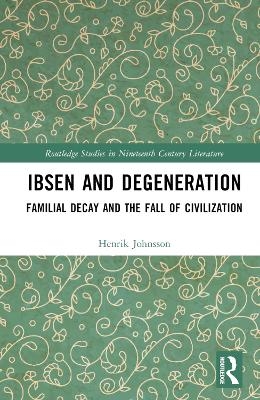
Ibsen and Degeneration
Routledge (Verlag)
978-1-032-74475-9 (ISBN)
Henrik Ibsen’s plays were written at a critical juncture in late-19th-century European culture. Appearing at a time when notions of evolution and heredity were commonplace themes in literature and the arts, Ibsenian drama highlights the creative potential offered by contemporary evolutionary thought. In his plays, Ibsen explores variations on the theme of degeneration, imagining how families can become affected by ill-health or other forms of “weakness” that lead to the extinction of the family line. Ibsen and Degeneration looks at the recurrence of ideas of degeneration in three of Ibsen’s plays: In Ghosts, it is the motif of syphilis, highly shocking to Ibsen’s contemporaries, which serves as an allegory of degeneration. In Rosmersholm, degeneration is reconfigured as an overcultivation that eventually makes a family unfit for life. In Hedda Gabler, meanwhile, Hedda, having been for all practical purposes raised as a man, has come to think of herself as one, a circumstance which informs her final decision to end her life – her final degeneration. By reading these three plays from a fresh perspective, Ibsen and Degeneration sheds new light on some of Ibsen’s most enduring contributions to world drama.
The Open Access version of this book, available at http://www.taylorfrancis.com, has been made available under a Creative Commons Attribution-Non Commercial-No Derivatives (CC-BY-NC-ND) 4.0 license.
Henrik Johnsson is Professor of Nordic Literature at Østfold University College, Norway. He holds a PhD in the history of literature from Stockholm University. He is the author of two monographs on the oeuvre of August Strindberg – Strindberg and Horror: Horror Motifs and the Theme of Identity in the Works of August Strindberg (2009) and The Infinite Coherence: August Strindberg’s Occult Science (2015). He is coeditor with Tessel M. Bauduin of the anthology The Occult in Modernist Art, Literature, and Cinema (2018). His current research explores the intersection of horror and desire in Nordic Gothic fiction.
Introduction
Morel and the rise of degeneration discourse
Marriage, family, and incest
Disease, diathesis, and syphilis
Energetic economy and the fixed fund of energy theory
What does Ibsen do with degeneration discourse?
A note on the form and scope of the book
Chapter 1. The Rot of the Bourgeois Body: Ghosts (1881)
Ibsen’s commentary on Ghosts
The raising of bourgeois children
Class, health, and sex
Bourgeois patriarchy and Helene’s independence
Alving’s decline and fall
Osvald’s energetic inheritance
Regine and regeneration
Chapter 2. The Fall of the Old Order: Rosmersholm (1886)
Hvide heste and its relationship to Rosmersholm
Rosmer, Kroll, and the fall of the old order
Marriage as the scene of threats to the social fabric
Strength and weakness of will
Brendel and the forces of entropy
The useless deaths of Rosmer and Rebekka
Chapter 3. Dominance and Deviance: Hedda Gabler (1890)
August Strindberg’s “For Payment” as intertext
Degeneration in Ibsen’s notes to Hedda Gabler
The question of Hedda’s sexuality
Tesman as failed patriarch
Hedda’s need for domination
Løvborg’s loss of manhood
Sexual competition and exclusivity
Hedda’s wasteful death
4. Conclusion
| Erscheinungsdatum | 11.07.2024 |
|---|---|
| Reihe/Serie | Routledge Studies in Nineteenth Century Literature |
| Verlagsort | London |
| Sprache | englisch |
| Maße | 152 x 229 mm |
| Gewicht | 557 g |
| Themenwelt | Geisteswissenschaften ► Sprach- / Literaturwissenschaft ► Anglistik / Amerikanistik |
| Geisteswissenschaften ► Sprach- / Literaturwissenschaft ► Literaturgeschichte | |
| Geisteswissenschaften ► Sprach- / Literaturwissenschaft ► Literaturwissenschaft | |
| ISBN-10 | 1-032-74475-8 / 1032744758 |
| ISBN-13 | 978-1-032-74475-9 / 9781032744759 |
| Zustand | Neuware |
| Haben Sie eine Frage zum Produkt? |
aus dem Bereich


